remote control TOYOTA HIGHLANDER 2013 XU50 / 3.G Owners Manual
[x] Cancel search | Manufacturer: TOYOTA, Model Year: 2013, Model line: HIGHLANDER, Model: TOYOTA HIGHLANDER 2013 XU50 / 3.GPages: 684, PDF Size: 15.42 MB
Page 2 of 684

TABLE OF CONTENTSIndex
2
1-1. Key informationKeys ..................................... 32
1-2. Opening, closing and locking the doors
Smart key system................. 35
Wireless remote control ....... 48
Side doors ............................ 54
Back door ............................. 60
Glass hatch .......................... 70
1-3. Adjustable components (seats, mirrors,
steering wheel)
Front seats ........................... 74
Rear seats ............................ 77
Head restraints ..................... 85
Seat belts ............................. 88
Steering wheel ..................... 94
Anti-glare inside rear view mirror.......................... 95
Outside rear view mirrors ..... 98
1-4. Opening and closing the windows and moon roof
Power windows .................. 101
Moon roof ........................... 104
1-5. Refueling Opening the fuel tank cap ................................... 109 1-6. Theft deterrent system
Engine immobilizer system .............................. 113
Alarm .................................. 117
Theft prevention labels (U.S.A.)............................. 121
1-7. Safety information Correct driving posture ....... 122
SRS airbags ....................... 124
Front passenger occupant classification system ......... 136
Child restraint systems ....... 143
Installing child restraints ..... 148
2-1. Driving procedures Driving the vehicle .............. 160
Engine (ignition) switch (vehicles with smart
key system) ...................... 171
Engine (ignition) switch (vehicles without smart
key system) ...................... 175
Automatic transmission ...... 178
Turn signal lever ................. 183
Parking brake ..................... 184
Horn .................................... 185
1Before driving
2When driving
Page 3 of 684
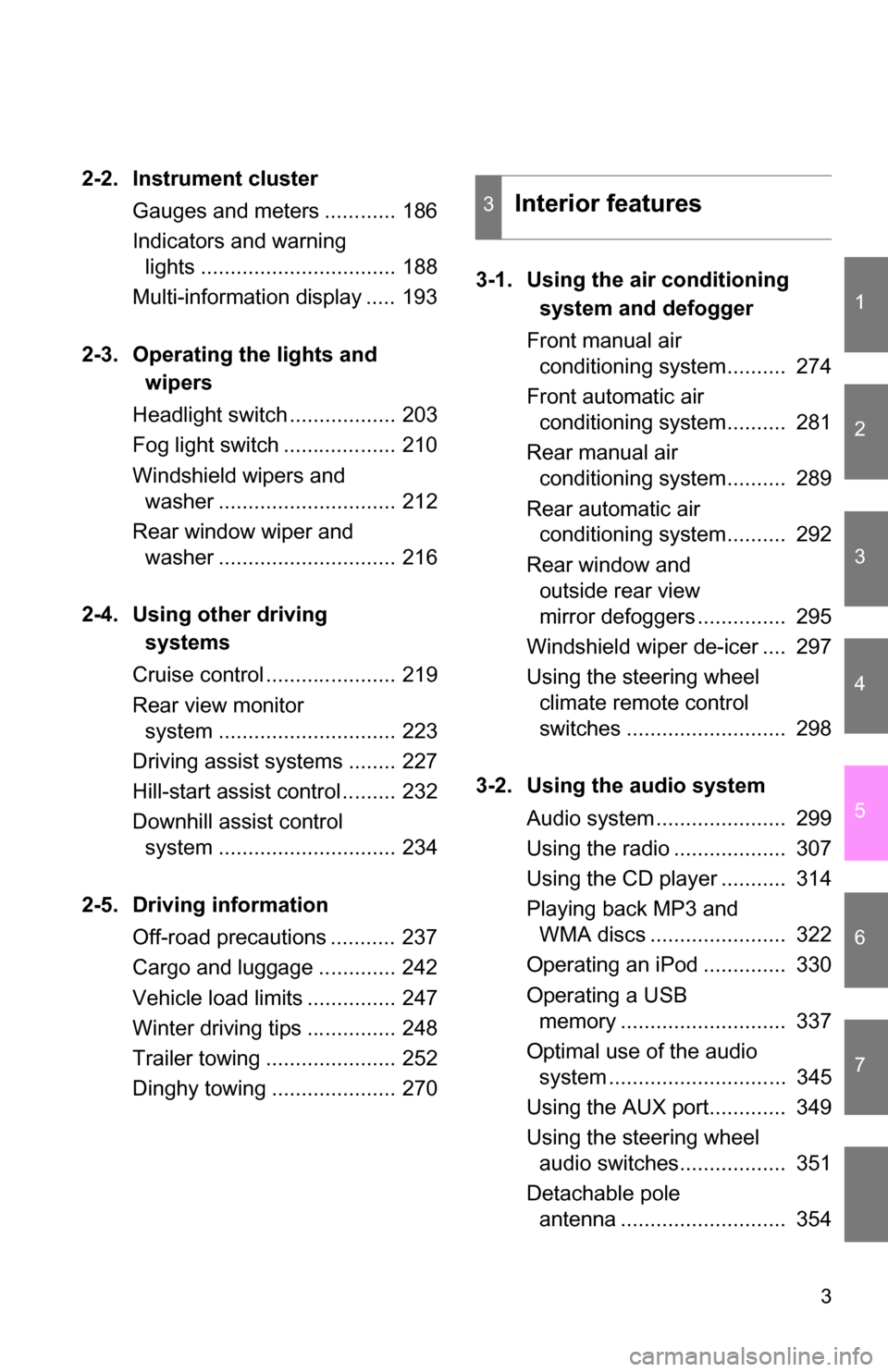
1
2
3
4
5
6
7
3
2-2. Instrument clusterGauges and meters ............ 186
Indicators and warning lights ................................. 188
Multi-information display ..... 193
2-3. Operating the lights and wipers
Headlight switch .................. 203
Fog light switch ................... 210
Windshield wipers and washer .............................. 212
Rear window wiper and washer .............................. 216
2-4. Using other driving systems
Cruise control ...................... 219
Rear view monitor system .............................. 223
Driving assist systems ........ 227
Hill-start assist control ......... 232
Downhill assist control system .............................. 234
2-5. Driving information Off-road precautions ........... 237
Cargo and luggage ............. 242
Vehicle load limits ............... 247
Winter driving tips ............... 248
Trailer towing ...................... 252
Dinghy towing ..................... 270 3-1. Using the air conditioning
system and defogger
Front manual air conditioning system.......... 274
Front automatic air conditioning system.......... 281
Rear manual air conditioning system.......... 289
Rear automatic air conditioning system.......... 292
Rear window and outside rear view
mirror defoggers ............... 295
Windshield wiper de-icer .... 297
Using the steering wheel climate remote control
switches ........................... 298
3-2. Using the audio system Audio system ...................... 299
Using the radio ................... 307
Using the CD player ........... 314
Playing back MP3 and WMA discs ....................... 322
Operating an iPod .............. 330
Operating a USB memory ............................ 337
Optimal use of the audio system .............................. 345
Using the AUX port............. 349
Using the steering wheel audio switches.................. 351
Detachable pole antenna ............................ 354
3Interior features
Page 5 of 684
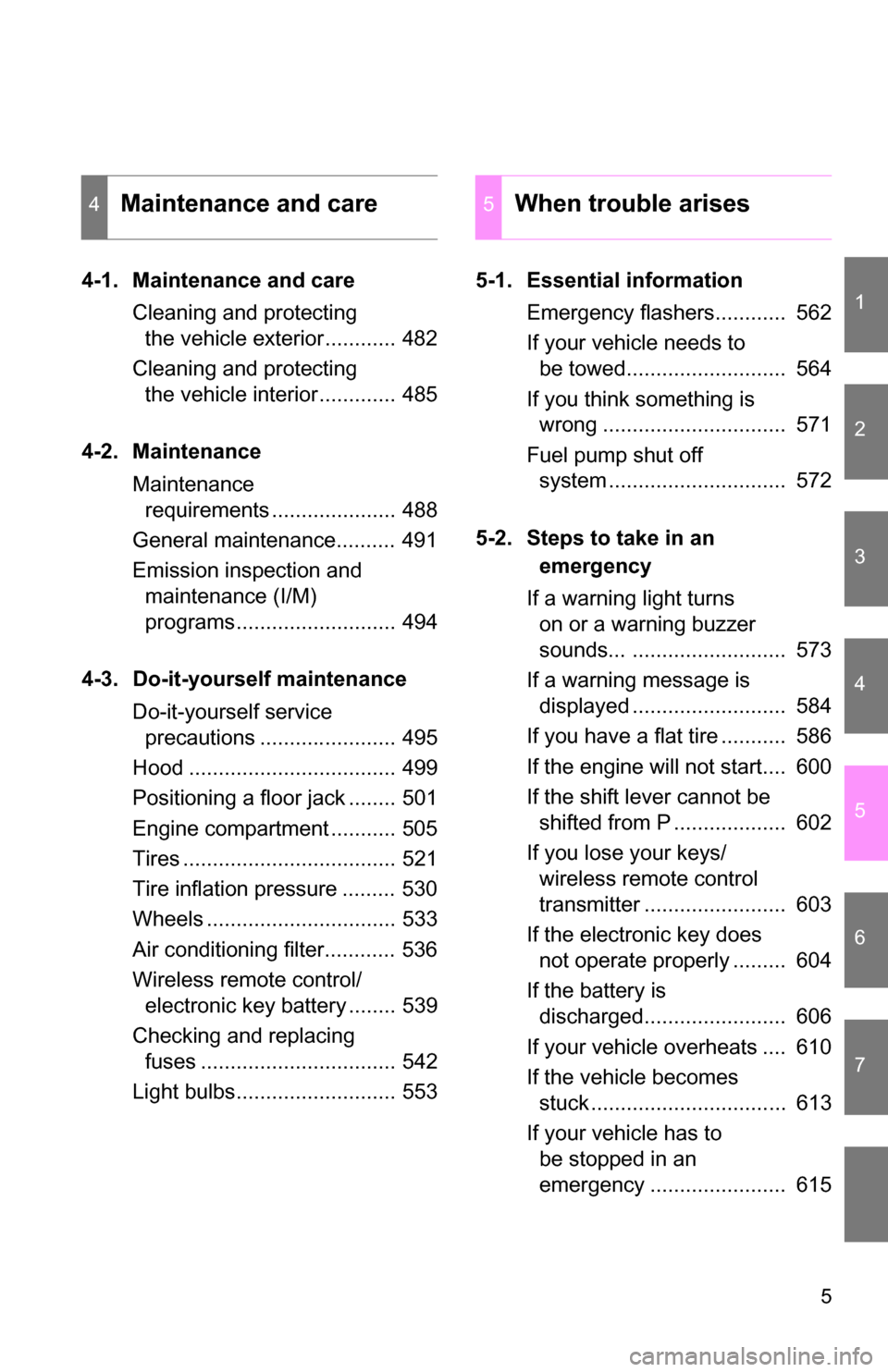
1
2
3
4
5
6
7
5
4-1. Maintenance and careCleaning and protecting the vehicle exterior............ 482
Cleaning and protecting the vehicle interior............. 485
4-2. Maintenance Maintenance requirements ..................... 488
General maintenance.......... 491
Emission inspection and maintenance (I/M)
programs........................... 494
4-3. Do-it-yourself maintenance Do-it-yourself service precautions ....................... 495
Hood ................................... 499
Positioning a floor jack ........ 501
Engine compartment ........... 505
Tires .................................... 521
Tire inflation pressure ......... 530
Wheels ................................ 533
Air conditioning filter............ 536
Wireless remote control/ electronic key battery ........ 539
Checking and replacing fuses ................................. 542
Light bulbs........................... 553 5-1. Essential information
Emergency flashers............ 562
If your vehicle needs to be towed........................... 564
If you think something is wrong ............................... 571
Fuel pump shut off system .............................. 572
5-2. Steps to take in an emergency
If a warning light turns on or a warning buzzer
sounds... .......................... 573
If a warning message is displayed .......................... 584
If you have a flat tire ........... 586
If the engine will not start.... 600
If the shift lever cannot be shifted from P ................... 602
If you lose your keys/ wireless remote control
transmitter ........................ 603
If the electronic key does not operate properly ......... 604
If the battery is discharged........................ 606
If your vehicle overheats .... 610
If the vehicle becomes stuck ................................. 613
If your vehicle has to be stopped in an
emergency ....................... 615
4Maintenance and care5When trouble arises
Page 18 of 684
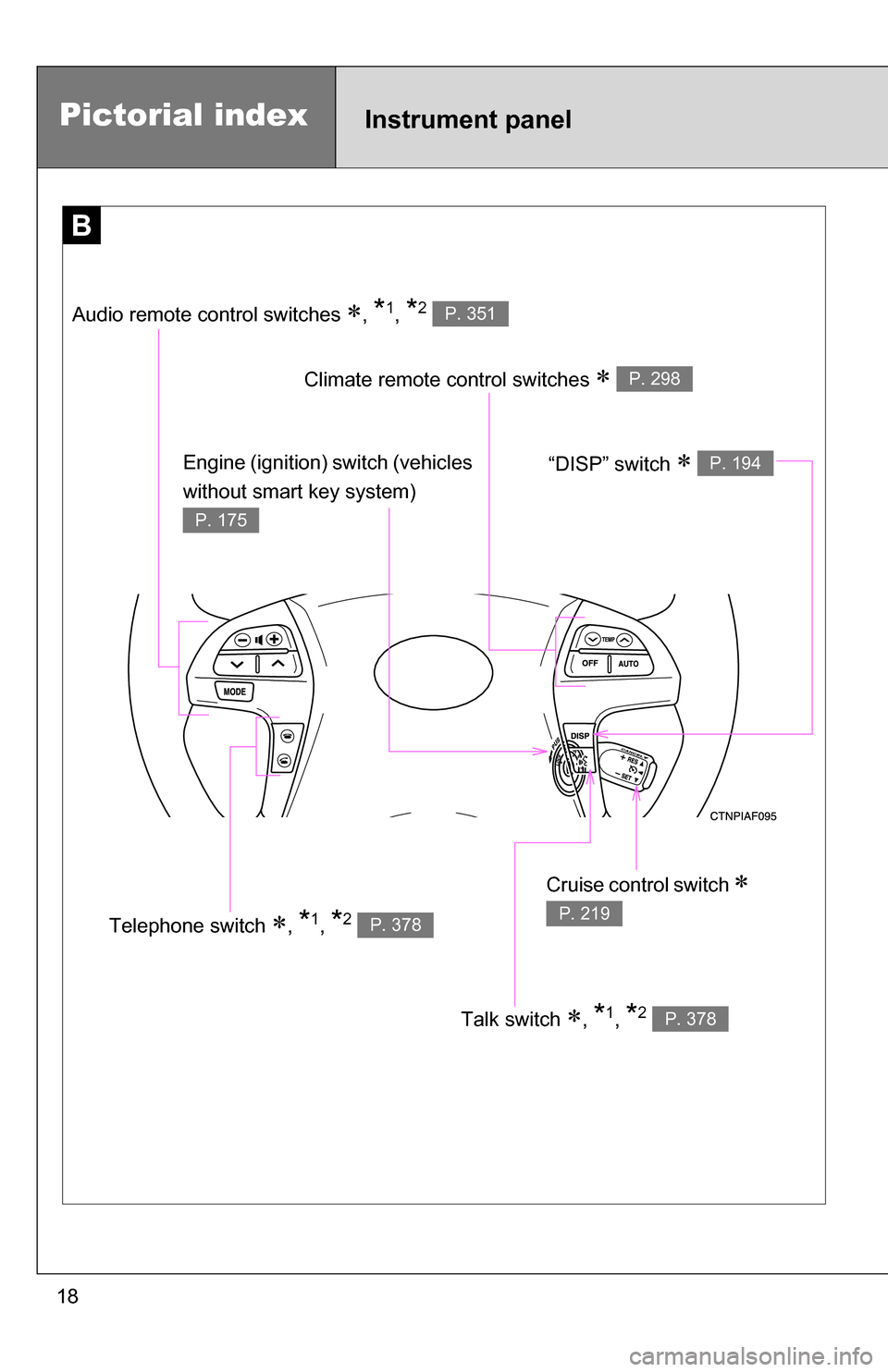
18
B
Talk switch , *1, *2 P. 378
Pictorial indexInstrument panel
Audio remote control switches , *1, *2 P. 351
Climate remote control switches P. 298
Cruise control switch
P. 219Telephone switch , *1, *2 P. 378
Engine (ignition) switch (vehicles
without smart key system)
P. 175
“DISP” switch P. 194
Page 31 of 684

Before driving1
31
1-1. Key informationKeys ................................... 32
1-2. Opening, closing and locking the doors
Smart key system .............. 35
Wireless remote control ..... 48
Side doors .......................... 54
Back door ........................... 60
Glass hatch ........................ 70
1-3. Adjustable components (seats, mirrors,
steering wheel)
Front seats ......................... 74
Rear seats.......................... 77
Head restraints................... 85
Seat belts ........................... 88
Steering wheel ................... 94
Anti-glare inside rear view mirror ....................... 95
Outside rear view mirrors.............................. 98 1-4. Opening and closing the
windows and moon roof
Power windows ................ 101
Moon roof ......................... 104
1-5. Refueling Opening the fuel tank cap ................................. 109
1-6. Theft deterrent system Engine immobilizer system ........................... 113
Alarm................................ 117
Theft prevention labels (U.S.A.) .......................... 121
1-7. Safety information Correct driving posture..... 122
SRS airbags ..................... 124
Front passenger occupant classification system ...... 136
Child restraint systems..... 143
Installing child restraints ........................ 148
Page 32 of 684

32
1-1. Key information
Keys
The following keys are provided with the vehicle.
Vehicles without smart key system (type A)
Master keys
Va l e t k e y
Key number plate
Vehicles without smar t key system (type B)
Master keys
Va l e t k e y
Key number plate
Vehicles with smart key system Electronic keys
• Operating the smart keysystem ( P. 35)
• Operating the wireless
remote control function
( P. 48)
Mechanical keys
Key number plate
Page 40 of 684
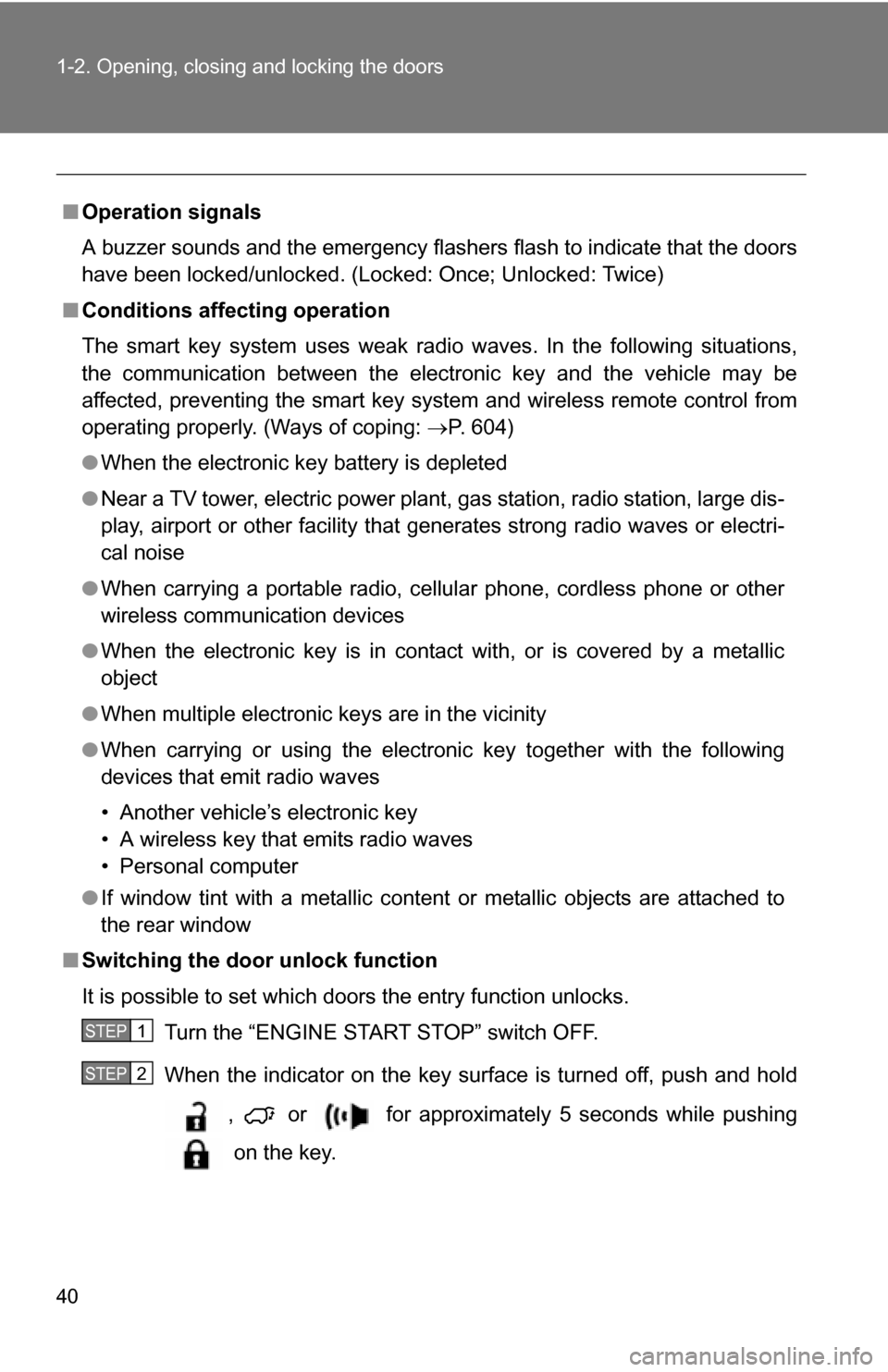
40 1-2. Opening, closing and locking the doors
■Operation signals
A buzzer sounds and the emergency flashers flash to indicate that the doors
have been locked/unlocked. (Locked: Once; Unlocked: Twice)
■ Conditions affecting operation
The smart key system uses weak radio waves. In the following situations,
the communication between the electronic key and the vehicle may be
affected, preventing the smart key system and wireless remote control from
operating properly. (Ways of coping: P. 604)
● When the electronic key battery is depleted
● Near a TV tower, electric power plant, gas station, radio station, large dis-
play, airport or other facility that generates strong radio waves or electri-
cal noise
● When carrying a portable radio, ce llular phone, cordless phone or other
wireless communication devices
● When the electronic key is in contact with, or is covered by a metallic
object
● When multiple electronic keys are in the vicinity
● When carrying or using the electronic key together with the following
devices that emit radio waves
• Another vehicle’s electronic key
• A wireless key that emits radio waves
• Personal computer
● If window tint with a metallic content or metallic objects are attached to
the rear window
■ Switching the door unlock function
It is possible to set which doors the entry function unlocks.
Turn the “ENGINE START STOP” switch OFF.
When the indicator on the key surface is turned off, push and hold
, or for approximately 5 seconds while pushing
on the key.
STEP1
STEP2
Page 41 of 684
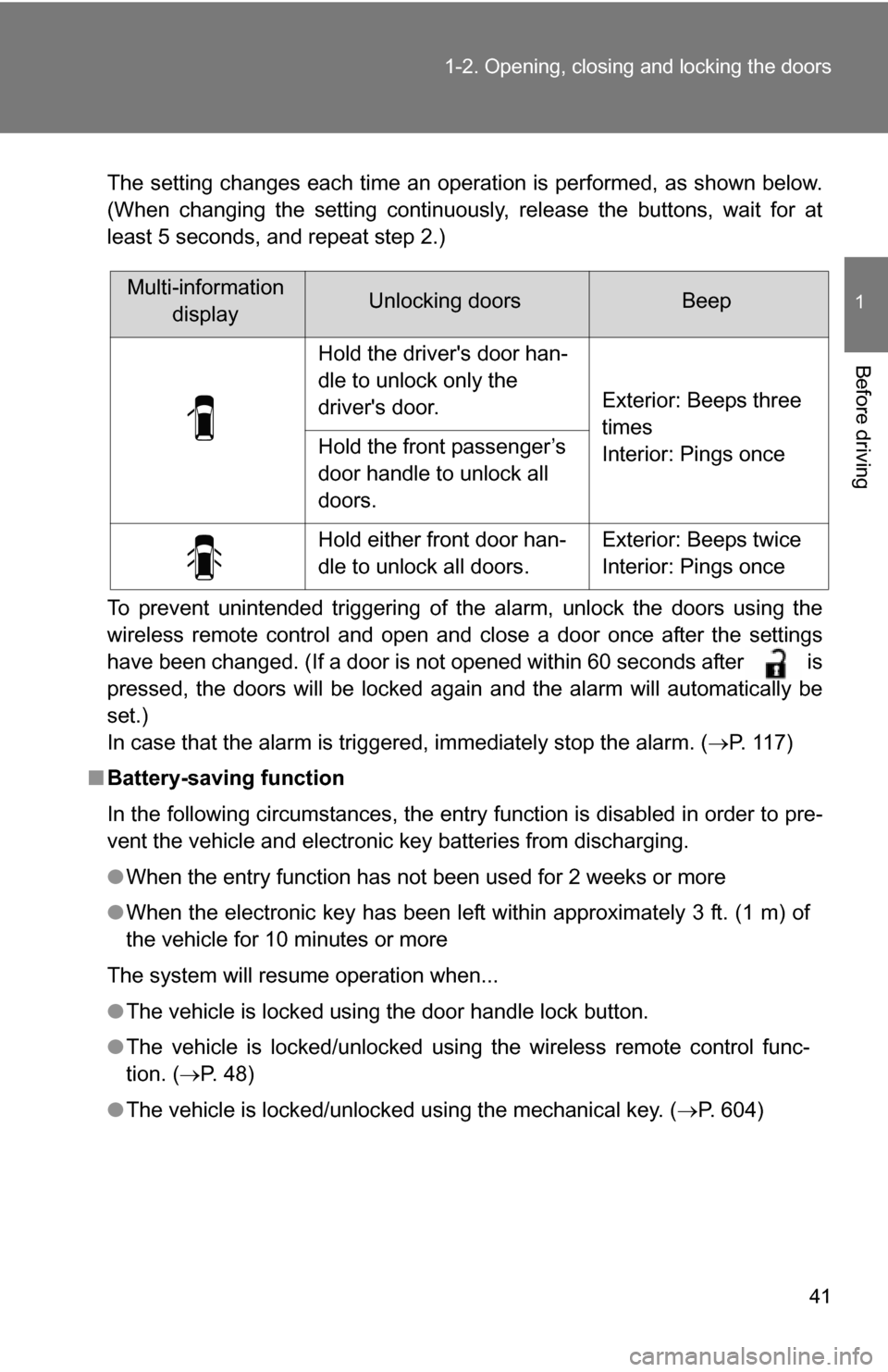
41
1-2. Opening, closing and locking the doors
1
Before driving
The setting changes each time an operation is performed, as shown below.
(When changing the setting continuously, release the buttons, wait for at
least 5 seconds, and repeat step 2.)
To prevent unintended triggering of the alarm, unlock the doors using the
wireless remote control and open and close a door once after the settings
have been changed. (If a door is not opened within 60 seconds after is
pressed, the doors will be locked again and the alarm will automatically be
set.)
In case that the alarm is triggered, immediately stop the alarm. (P. 1 1 7 )
■ Battery-saving function
In the following circumstances, the entry function is disabled in order to pre-
vent the vehicle and electronic key batteries from discharging.
●When the entry function has not been used for 2 weeks or more
● When the electronic key has been left within approximately 3 ft. (1 m) of
the vehicle for 10 minutes or more
The system will resume operation when...
● The vehicle is locked using the door handle lock button.
● The vehicle is locked/unlocked using the wireless remote control func-
tion. ( P. 48)
● The vehicle is locked/unlocked using the mechanical key. ( P. 604)
Multi-information
displayUnlocking doorsBeep
Hold the driver's door han-
dle to unlock only the
driver's door.
Exterior: Beeps three
times
Interior: Pings once
Hold the front passenger’s
door handle to unlock all
doors.
Hold either front door han-
dle to unlock all doors.Exterior: Beeps twice
Interior: Pings once
Page 42 of 684
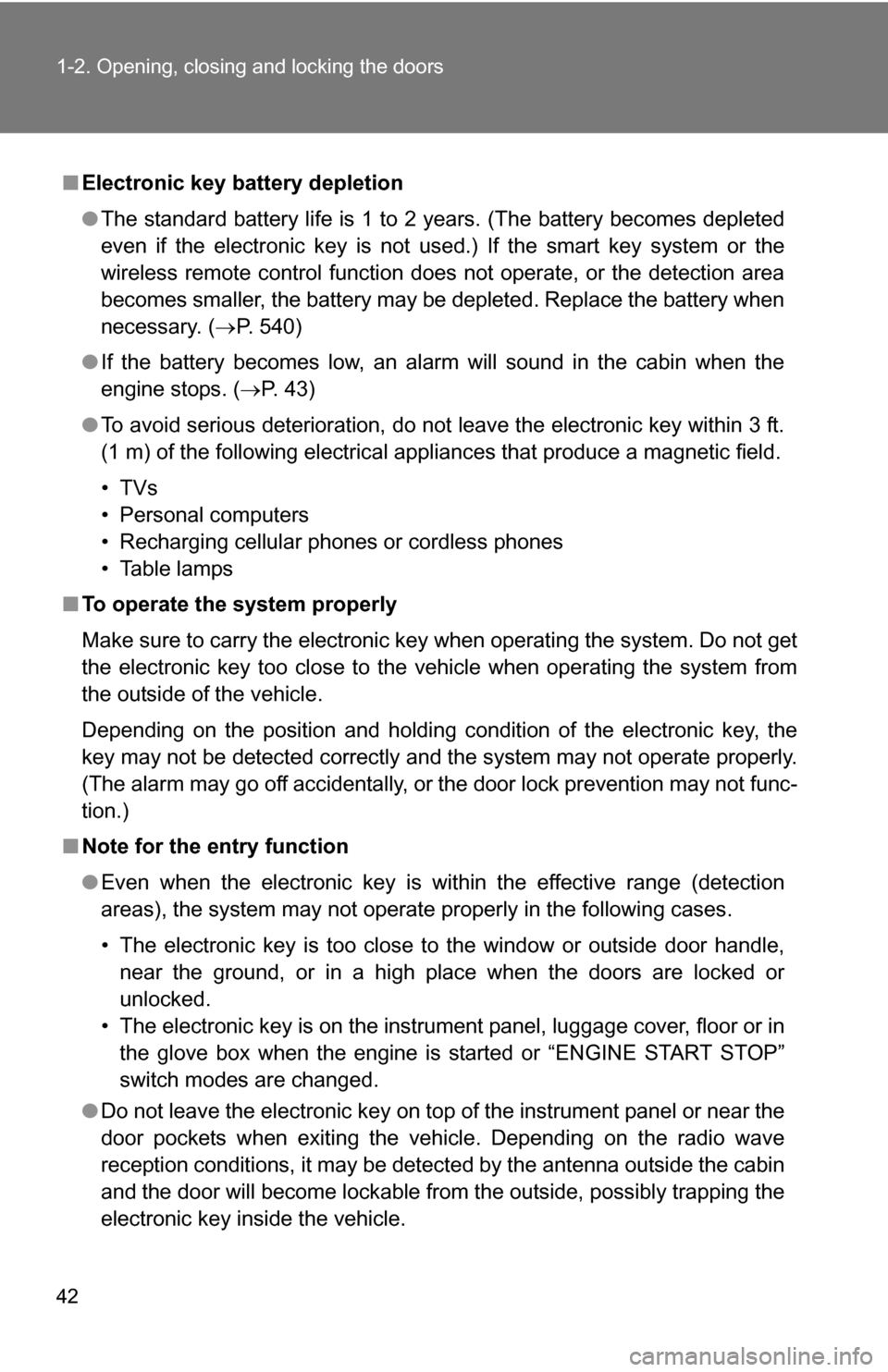
42 1-2. Opening, closing and locking the doors
■Electronic key battery depletion
●The standard battery life is 1 to 2 years. (The battery becomes depleted
even if the electronic key is not used.) If the smart key system or the
wireless remote control function does not operate, or the detection area
becomes smaller, the battery may be depleted. Replace the battery when
necessary. ( P. 540)
● If the battery becomes low, an alarm will sound in the cabin when the
engine stops. ( P. 43)
● To avoid serious deterioration, do not leave the electronic key within 3 ft.
(1 m) of the following electrical appliances that produce a magnetic field.
•TVs
• Personal computers
• Recharging cellular phones or cordless phones
• Table lamps
■ To operate the system properly
Make sure to carry the electronic key when operating the system. Do not get
the electronic key too close to the vehicle when operating the system from
the outside of the vehicle.
Depending on the position and holding condition of the electronic key, the
key may not be detected correctly and the system may not operate properly.
(The alarm may go off accidentally, or the door lock prevention may not func-
tion.)
■ Note for the entry function
●Even when the electronic key is within the effective range (detection
areas), the system may not operate properly in the following cases.
• The electronic key is too close to the window or outside door handle,
near the ground, or in a high place when the doors are locked or
unlocked.
• The electronic key is on the instrument panel, luggage cover, floor or in the glove box when the engine is started or “ENGINE START STOP”
switch modes are changed.
● Do not leave the electronic key on top of the instrument panel or near the
door pockets when exiting the vehicle. Depending on the radio wave
reception conditions, it may be detected by the antenna outside the cabin
and the door will become lockable from the outside, possibly trapping the
electronic key inside the vehicle.
Page 43 of 684
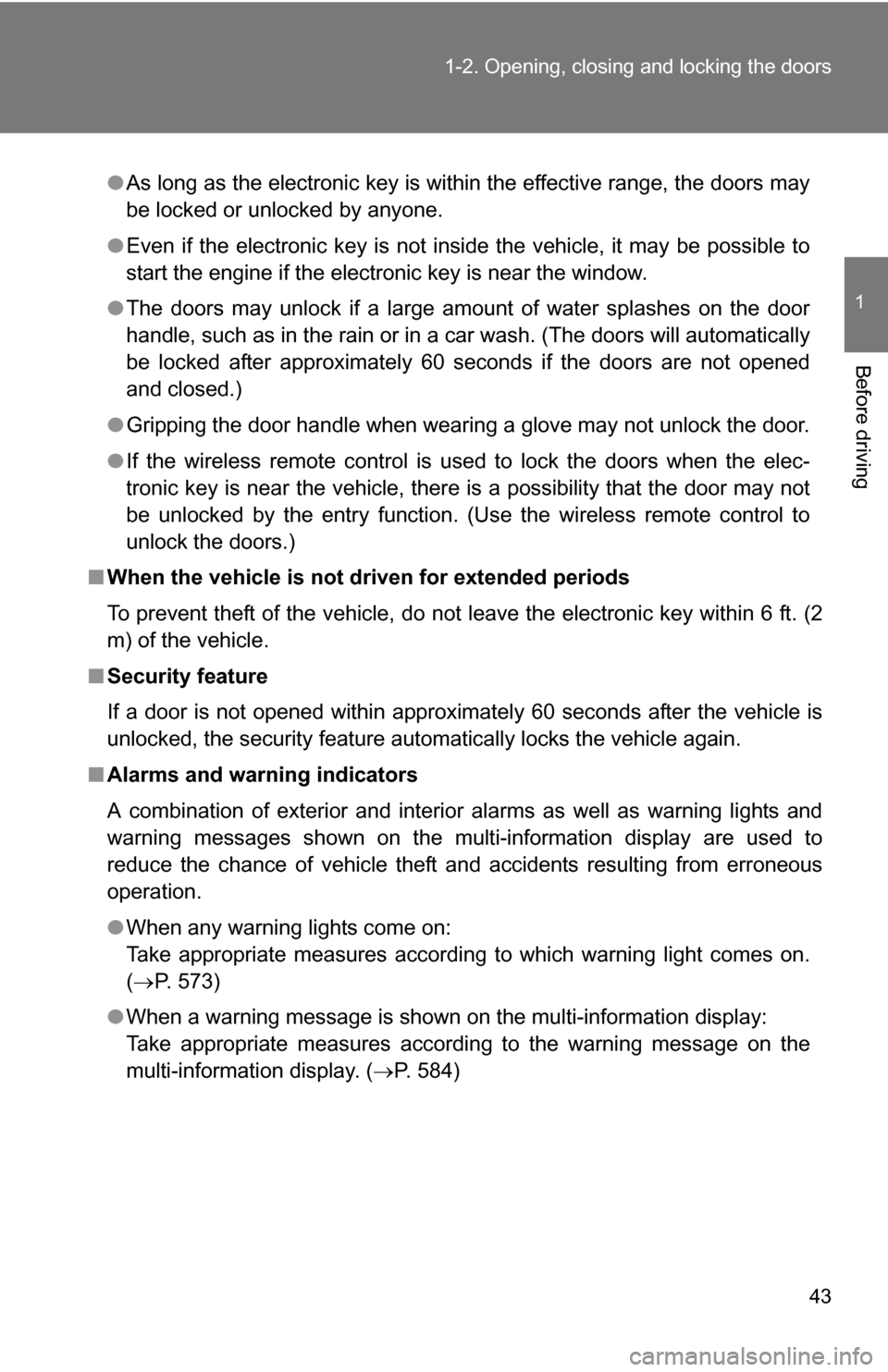
43
1-2. Opening, closing and locking the doors
1
Before driving
●
As long as the electronic key is within the effective range, the doors may
be locked or unlocked by anyone.
● Even if the electronic key is not inside the vehicle, it may be possible to
start the engine if the electronic key is near the window.
● The doors may unlock if a large amount of water splashes on the door
handle, such as in the rain or in a car wash. (The doors will automatically
be locked after approximately 60 seconds if the doors are not opened
and closed.)
● Gripping the door handle when wearing a glove may not unlock the door.
● If the wireless remote control is used to lock the doors when the elec-
tronic key is near the vehicle, there is a possibility that the door may not
be unlocked by the entry function. (Use the wireless remote control to
unlock the doors.)
■ When the vehicle is not dr iven for extended periods
To prevent theft of the vehicle, do not leave the electronic key within 6 ft. (2
m) of the vehicle.
■ Security feature
If a door is not opened within approximately 60 seconds after the vehicle is
unlocked, the security feature automatically locks the vehicle again.
■ Alarms and warning indicators
A combination of exterior and interior alarms as well as warning lights and
warning messages shown on the multi-information display are used to
reduce the chance of vehicle theft and accidents resulting from erroneous
operation.
●When any warning lights come on:
Take appropriate measures according to which warning light comes on.
( P. 573)
● When a warning message is shown on the multi-information display:
Take appropriate measures according to the warning message on the
multi-information display. ( P. 584)